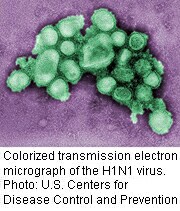
WEDNESDAY, June 9 (HealthDay News) — The novel H1N1 flu seems to share many characteristics with the seasonal flu it has largely replaced, a new study indicates.
“Our results are further confirmation that 2009 pandemic H1N1 and seasonal flu have similar transmission dynamics. People seem to be similarly infectious when ill with either pandemic or seasonal flu, and the viruses are likely to spread in similar ways,” said Benjamin Cowling, lead author of a study appearing in the June 10 issue of the New England Journal of Medicine.
The good news is that this means the preventive measures health authorities have been recommending, such as frequent hand washing, should be equally effective against pandemic flu.
“Influenza is very difficult to contain, but current measures including the availability of pandemic H1N1 vaccines should be able to mitigate the worst of any further epidemics,” added Cowling, who is an assistant professor at the School of Public Health at the University of Hong Kong.
Cowling and his colleagues followed 284 household members of 99 individuals who had tested positive for H1N1.
Eight percent of the household contacts also fell ill with the H1N1 virus, about the same transmission rate as seen for the seasonal flu (9 percent), the researchers found.
Viral shedding (when the virus replicates and leaves the body), as well as the pattern of actual sickness, were also similar for the two types of flu.
The “attack rate” (meaning the proportion of people in the entire population who get sick) for H1N1 was higher than that for seasonal flu and the difference was most pronounced among children. The authors hypothesized that this might be due to the fact that younger people seem to have lower natural immunity to the virus.
The patients in this study who were given oseltamivir (Tamiflu) did seem to have reduced antibody levels.
“This would suggest that maybe oseltamivir may result in a less vigorous immune response [than people who are not treated with this drug],” said Dr. John J. Treanor, professor of medicine and of microbiology and immunology at the University of Rochester Medical Center.
“That is very different from studies looking at seasonal flu, where there doesn’t appear to be any effect of oseltamivir on antibody response. This should be looked at more closely. It’s potentially important in terms of long-term susceptibility to re-infection. Susceptibility might be different in someone treated with oseltamivir who is not vaccinated. They might have enhanced susceptibility,” Treanor added.
A second study in the journal found that giving Tamiflu prophylactically (as a prevention measure) to people confined in close quarters — in this case, military installations — seemed to stem outbreaks.
Flu is also more likely to spread and spread faster in enclosed places such as schools and hospitals, in addition to military facilities.
In this study, Tamiflu was given to 1,100 personnel out of a total of 1,175 personnel. Before the intervention, 6.4 percent of individuals were infected, compared with only 0.6 percent after Tamiflu was introduced.
On average, a person who came down with H1N1 spread the virus to only 0.11 additional individuals after the intervention, versus almost two people before.
Although a vaccine is available for the 2009 H1N1 pandemic strain, Tamiflu might be an option in areas where the vaccine is not easily obtainable, stated the authors, who are with the Singapore Ministry of Defence and the National University of Singapore.
More information
The U.S. Centers for Disease Control and Prevention has more on the H1N1 flu.

